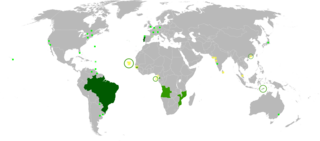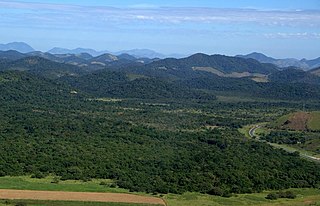| Saltinho Biological Reserve | |
|---|---|
| Reserva Biológica de Saltinho | |
IUCN category Ia (strict nature reserve) | |
Road in the reserve in April 2012 | |
| Nearest city | Tamandaré |
| Coordinates | 8°43′34″S35°10′44″W / 8.726°S 35.179°W Coordinates: 8°43′34″S35°10′44″W / 8.726°S 35.179°W |
| Area | 562 hectares (1,390 acres) |
| Designation | Biological Reserve |
| Created | 21 September 1983 |
Saltinho Biological Reserve (Portuguese : Reserva Biológica de Saltinho) is a Biological Reserve near Tamandaré in the state of Pernambuco, Brazil. It contains a sample of the tropical Atlantic Forest biome.

Portuguese is a Western Romance language originating in the Iberian Peninsula. It is the sole official language of Portugal, Brazil, Cape Verde, Guinea-Bissau, Mozambique, Angola, and São Tomé and Príncipe. It also has co-official language status in East Timor, Equatorial Guinea and Macau in China. As the result of expansion during colonial times, a cultural presence of Portuguese and Portuguese creole speakers are also found in Goa, Daman and Diu in India; in Batticaloa on the east coast of Sri Lanka; in the Indonesian island of Flores; in the Malacca state of Malaysia; and the ABC islands in the Caribbean where Papiamento is spoken, while Cape Verdean Creole is the most widely spoken Portuguese-based Creole. A Portuguese-speaking person or nation may be referred to as "Lusophone" in both English and Portuguese.

A biological reserve in Brazil is a legally defined type of protected area of Brazil, a conservation unit that aims for full preservation of biota and other natural attributes without human interference. It may be visited only with prior approval of the responsible agency, and only for research or educational purposes.

Tamandaré is a coastal municipality about 103 km (64 mi) south of Recife, the capital city of the Brazilian state of Pernambuco.













